China Airlines flight 120: Explosion at the Gate
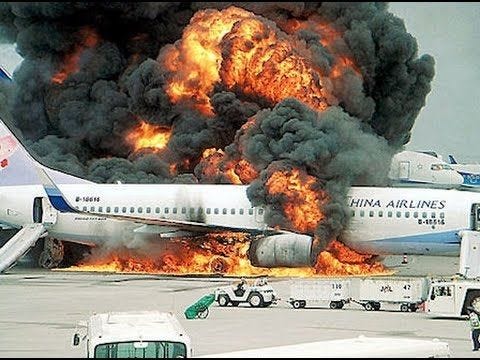
On the 20th of August 2007, China Airlines flight 120 arrived at Naha Airport on the Japanese island of Okinawa after a flight from Taipei. The Boeing 737 taxied to the gate and parked on the apron, the pilots shut off the engines, and the passengers prepared to disembark. Then, all of a sudden, a fire erupted on the left engine, sending the 165 passengers and crew scrambling to escape as the blaze rapidly consumed the plane. Miraculously, everyone managed to get off just before the plane exploded, and nobody was seriously injured. But investigators knew that next time they might not be so lucky. Digging into the events that led to the fire, they discovered that the origins of the near-disaster in what should have been the safest phase of flight could be traced back to a single missing washer.
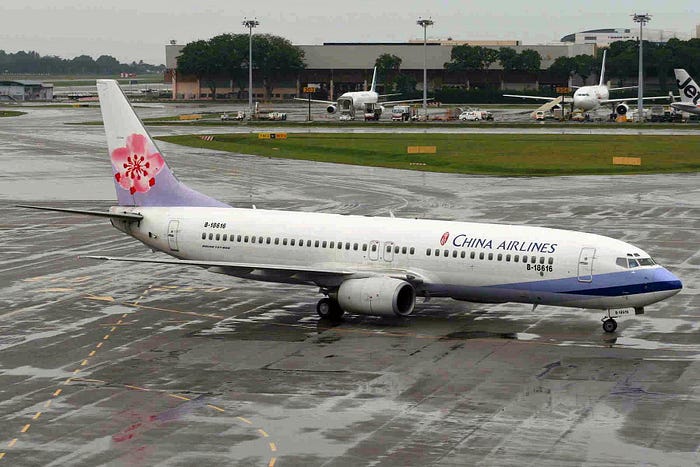
China Airlines flight 120 was a five-year-old Boeing 737–800 operating a regular flight with Taiwan’s national air carrier from Taipei, Taiwan, to the Japanese island of Okinawa. Flight 120 left Taipei’s Taiwan Taoyuan International Airport at 9:21 a.m. with 157 passengers and 8 crew on board, flew for an hour and six minutes, and landed normally at Naha Airport on Okinawa at 10:27. The crew taxied the plane off the runway, de-configuring the plane according to the after landing checklist as they went. After about a minute, they retracted the flaps and slats, the control surfaces that increase lift for takeoff and landing. It was this entirely innocuous action that set in motion a dangerous unforeseen chain of events.
The story of flight 120 actually began more than a month earlier in a China Airlines maintenance facility back on Taiwan. This particular Boeing 737 was in for a C-check, an annual bout of heavy maintenance where airlines often take the opportunity to catch up on service bulletins put out by the manufacturer. One of these bulletins involved a small part called the slat downstop assembly.
The slats, the lifting surfaces that deploy from the leading edge of the wing, extend and retract by sliding a “slat track” in and out of the “track can.” When retracted, the slat track, attached to the inside edge of the slats, fits perfectly into the can, which is simply the hollow space inside the wing where the slat sits when not deployed. (The length of the slat track is such that the can extends into the fuel tank.) In order to prevent the slat track from moving too far out of the track can when the slats are deployed, a “downstop assembly” is attached to the back end of the slat track to make it physically too wide to pass through the front opening of the track can.
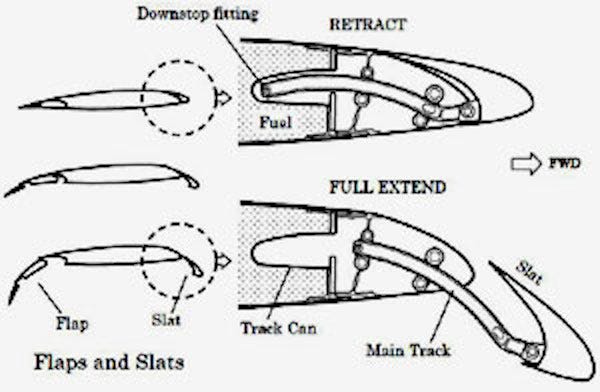
The downstop assembly is composed of two downstops attached to a bolt that runs through the slat track. The downstops are held on the bolt by a pair of washers and a nut. At some point, Boeing discovered that the nut on the slat downstop assembly could work its way loose over time, eventually causing the assembly to fall out. To prevent this from happening, Boeing issued a service bulletin requiring airlines to re-affix the nut with an adhesive that would prevent it from unscrewing from the bolt. China Airlines elected to carry out this procedure on the inboard slat on the right wing of this Boeing 737 while it was in for its C-check in July 2007.
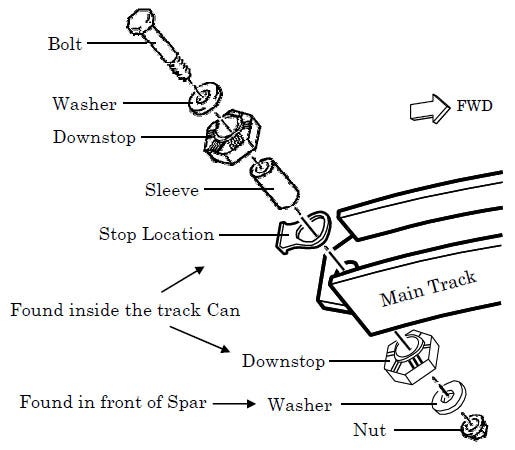
A maintenance supervisor, a maintenance engineer, and an assistant set about modifying the downstop assembly. To access the track can, they opened a small service door via the fuel tank that provided enough space to reach through but not enough to see what they were doing. While the assistant held on to the other end of the bolt, the maintenance engineer carefully removed the nut using a torque wrench. He then applied the adhesive to the nut, reached back through the hole, and screwed the nut back on. All of the work inside the track can had to be done by feel. While fumbling around inside the track can, the maintenance engineer accidentally bumped the downstop assembly and knocked the washer off the bolt. For whatever reason, the maintenance workers didn’t hear it tumble down into space inside the leading edge, so they finished attaching the nut and closed everything up again without noticing the missing washer. An inspector signed off on the job and that was that.
Little did anyone know, the absence of the washer compromised the entire downstop assembly. The washer is actually the only thing holding the nut-side downstop onto the bolt; without it, it can pass over the nut and slide right off. Below, an NTSB investigator demonstrates using an actual Boeing 737 slat track downstop assembly.

Over the next several weeks, the 737 flew all over East Asia with a loose downstop assembly in the right inboard slat. It took some time to wiggle its way out, but on flight 120 from Taipei to Okinawa, it finally disconnected from the slat track and fell into the empty track can.
This posed no danger to the safety of the flight, which landed without any sign of a problem. But when the pilots retracted the slats while taxiing to the gate, the slat track moved back into the track can, pushing the detached downstop assembly ahead of it. As the powerful hydraulic slat actuator moved the slat track into the fully retracted position, it shoved the downstop bolt straight through the wall of the track can, puncturing the fuel tank. Fuel began to rush out of the hole, flowing down the track can and out through the leading edge of the wing.
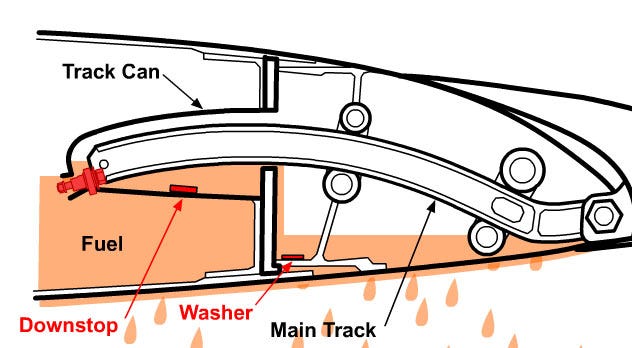
The flow wrapped around the underside of the wing and sprayed out onto the tarmac due to the exhaust blast from the right engine. Shortly thereafter, the 737 arrived at parking spot 41 in front of the international terminal. The pilots shut off the engines and the ground crew prepared to roll up the air stairs and chock the wheels. Then, suddenly, events began to spiral out of control.
When the engines were shut off, the path of the leaking fuel shifted, sending kerosene cascading straight down onto the right (number two) engine. Several workers on the ground saw the problem immediately, but before they could figure out what was happening, the jet fuel came in contact with scorching hot engine components and instantly ignited. Inside the plane, the passengers were already out of their seats collecting baggage from the overhead bins, unaware of the escalating situation. One of the marshaling staff had already hooked up the plane’s ground-to-cockpit interphone, and when the blaze broke out, he called the pilots and shouted, “Fire! Fire!”
The captain looked over his shoulder and spotted smoke rising through the side window. Over the crew interphone system, he ordered the flight attendants to their stations, where they would be ready to open the doors. On the ground, a maintenance engineer approached the right engine with a fire extinguisher, but the blaze was already much too large for him to handle, and he was forced to retreat. The captain pulled the engine fire extinguisher handle, but this too was useless because the fire was on the outside of the engine, not the inside. Smoke began to rise up and over the international terminal, catching the attention of the controllers in the tower. After checking the location of the fire on the CCTV screens, the ground controller picked up the crash phone and alerted the airport fire department, which immediately scrambled to respond.

Meanwhile, with the flames rapidly expanding around the right wing, the captain ordered the evacuation of the airplane. As astonished travelers in the adjacent terminal watched with cameras rolling, all four of the 737’s main doors opened, the slides deployed, and passengers began to pour from the plane. Within seconds, spilled fuel and a light breeze pushed the fire under the fuselage and spread it to the left wing as well. Passengers screamed and shouted as flames shot up on both sides of the cabin, causing the windows to crack from the intense heat. By virtue of the fact that most people were already lined up in the aisle when the emergency began, the flight attendants were able to get everyone down the slides and away from the plane in only two minutes. By now only the pilots were on board, but the center of the plane was rapidly being consumed by the now-enormous inferno.
To the bewilderment of many, there was still no sign of the fire trucks. The trucks were in fact having difficulties communicating with the control tower, and were unsure whether they had permission to cross a taxiway in which an airliner was actively taxiing. The frustrating communication problems cost valuable time, and eventually the firefighters decided to forge ahead without explicit clearance.
Back at spot 41, the pilots decided that it was time to abandon ship. Smoke had filled the cabin, so they decided to use the emergency escape rope to climb down through the cockpit window. The first officer went first, but just as he stepped through the window, a massive explosion rocked the plane. The ground shook and a great ball of fire twisted into the sky, sending nearby ground personnel and the evacuated cabin crew running for cover. The concussive blast knocked the first officer off the plane and sent him plummeting five meters down to the ground, but he miraculously escaped serious injury and was back on his feet within a couple of seconds. Shortly thereafter, the captain also bailed out through the same window and fled the scene. He looked back just in time to see the plane’s tail section collapse to the ground as the fire melted its way through the fuselage.

The passengers and crew gathered in the terminal, thankful at the very least that nobody was seriously hurt. Only now did the fire trucks finally arrive to fight the fire, which was sending up a plume of smoke that could be seen from across Okinawa. It took them an hour to put out the blaze, leaving the charred wreckage of flight 120 lying askew on the blackened concrete of parking spot 41.
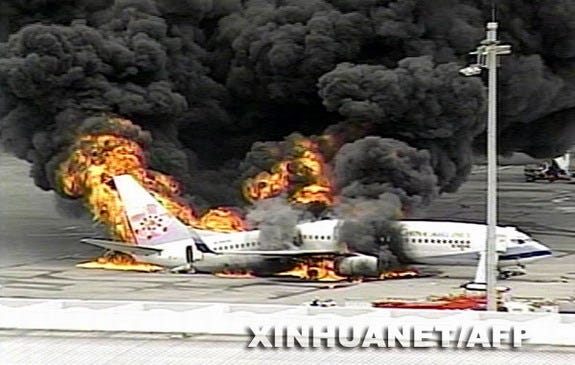
Although there were no deaths or serious injuries on China Airlines flight 120, this can largely be put down to the swift and orderly evacuation. In many ways, this accident was a perfect illustration of how much progress has been made since the 1985 fire on board British Airtours flight 28, a very similar incident that ended in tragedy. Although passengers later complained that they didn’t receive any instructions from the flight attendants, the fact that the evacuation was so successful indicates that they did what needed to be done, regardless of whether the passengers appreciated it or not.
However, investigators from Japan’s Aircraft and Railway Accidents Investigation Commission (ARAIC) were acutely aware that the outcome might not be so fortunate if this were to happen again. Over the course of an in-depth investigation, they managed to trace the cause of the spectacular fire and explosion to a single missing washer, perhaps the smallest and seemingly most insignificant part that has ever caused an air disaster.
The investigation report largely put the accident down to an unfortunate series of events in which no one was really at fault. The maintenance workers who serviced the downstop assembly certainly meant no harm, and they in fact followed proper procedure. It was the procedure itself that was flawed, forcing maintenance personnel to work in a tight space where they couldn’t see what they were doing. Although Boeing’s service bulletin was a good-faith attempt to prevent exactly this sort of accident, the investigators felt that the company should have put more thought into what it would take to actually carry out the procedure. Asking mechanics to work by feel through a small opening was always going to be a risk.
In its final report, the ARAIC recommended that the US Federal Aviation Administration supervise Boeing to ensure that maintenance instructions take into account the conditions under which the work must be performed. They sent a similar recommendation to Japan’s own aviation authority. The Civil Aviation Bureau of Japan took some action on its own, mandating inspections of the slat downstop assemblies on Boeing 737s using a new process that would make it easier to access the mechanism. The FAA and Taiwan’s Civil Aeronautics Administration both followed suit, issuing identical recommendations a few days later. Boeing also made design changes to the downstop assembly and to the leading edge of the wing that would prevent leaking fuel from flowing onto the engine. And finally, the CAB ordered airport authorities to set up an emergency communication line that would allow controllers to speak to all fire trucks simultaneously, and improved training for firefighters to help them respond more quickly. International rules call for fire trucks to be able to reach an accident anywhere within the airport boundary in three minutes or less, but during the China Airlines accident, they failed to do so. Luckily, this did not cost any lives, but the CAB nevertheless used it as a learning opportunity that could help save lives next time.
_________________________________________________________________
Follow this link to join the discussion of this article on Reddit!
You can also visit reddit.com/r/admiralcloudberg to read more than 100 similar articles.
